The beginner’s guide to messaging & storytelling.
Seven tools that drive clarity, confidence & conversions

KEVIN L. BROWN
In the 1999 cult classic film Office Space, fans often quote a memorable scene. It reminds me of many nonprofit and social enterprise leaders.
The distressed software engineer Tom is being interrogated by two efficiency consultants. And he can’t seem to explain his overly complex customer service role. So, after much confusion, the two Bobs try a simpler tact:
“What would you say you do here?”
Urban legend says Steve Jobs asked a similar question to a young employee on an elevator. Just making small talk. Tongue-tied by stardom, she apparently didn’t answer him clearly enough. And Jobs fired her on the spot.
But this isn’t just the stuff of fiction.
We once sat across the lunch table from a sadly similar conversation at a funder’s annual conference. A grantmaker was giving two social entrepreneurs the chance to pitch her. They rambled on and on with incoherent buzzwords. Empowerment this, holistic that, transformation, community-led, scalable, systems change. She kindly kept asking, “Can you please tell me what you actually do?” Then she finally gave up and said; “Check out our foundation’s website. If you think what you do matches what we fund, get in touch.”
Ouch.
What do these three mortifying moments have in common? A missed messaging opportunity. People incapable of merely explaining their work — much less storytelling about it in a compelling way.
Sound familiar? Struggling with clarity, confidence, and converting conversations? Read on for our beginner’s guide.
First up, what messaging and storytelling is — and isn’t. Second, why it matters. And third, how to create a messaging and storytelling platform.
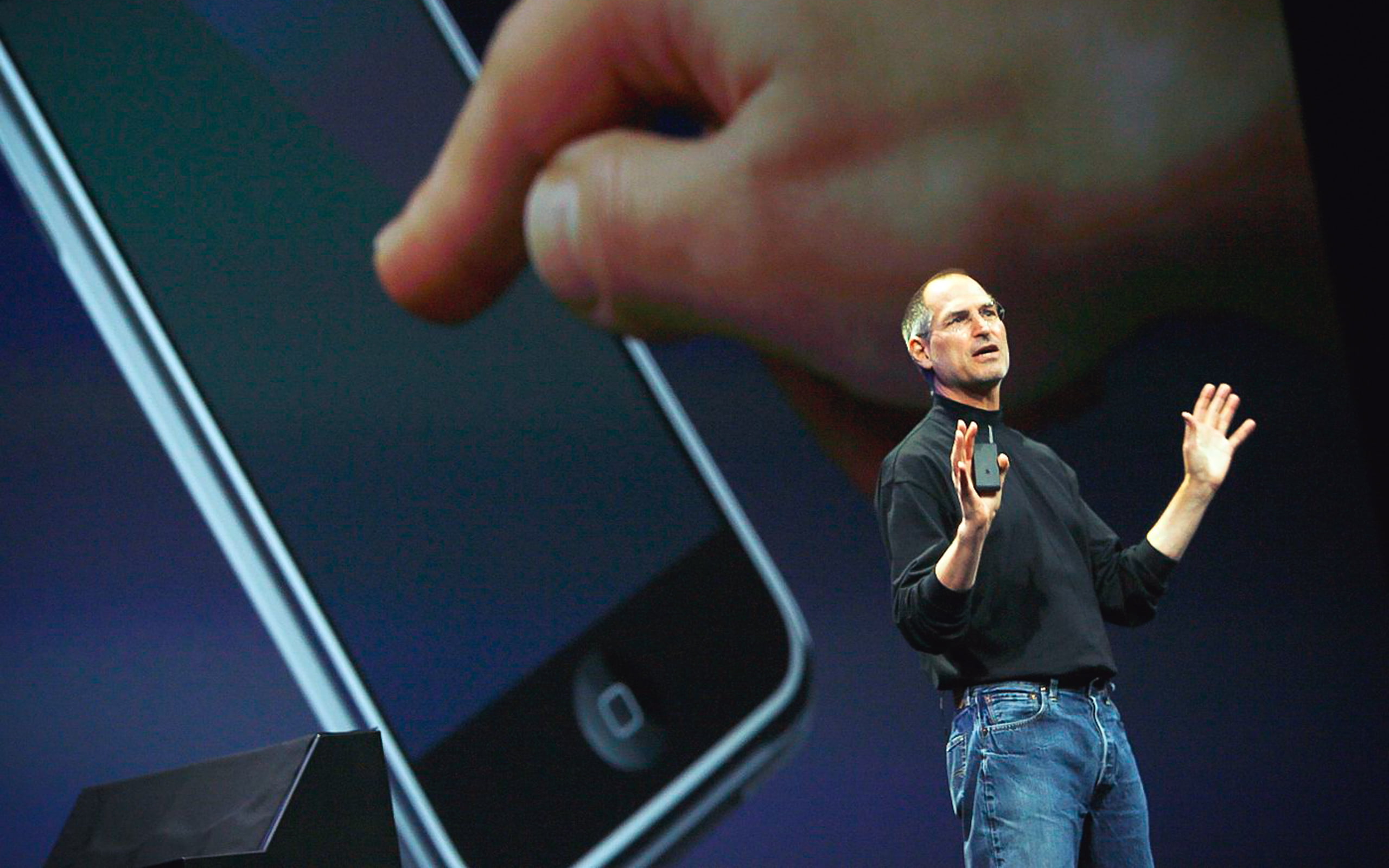
Many consider Steve Jobs the best storyteller the world has ever known. He could accurately and succinctly message what Apple products could do. But, also tell the story to captivate audiences with product advantages and benefits. Not trying to convert customers based on functional features that every competitor already had.
What it is: a few definitions, first.
Messaging & storytelling platform
This is the written and verbal companion to your brand’s visual style guide. Or the core, foundational, strategic building blocks that direct how you write and talk about your social venture. It’s a content starter bank. Tools, terms, statements, and copy blocks to pull from when writing a newsletter, updating a website, or drafting a presentation for a donor meeting.
The platform should be arranged hierarchically to establish a language priority. Ensuring the essential points about your cause shine through. That’s why it’s sometimes called messaging architecture or a messaging framework. Because it acts “as scaffolding for your content, supporting and shaping the content you actually produce,” Erin Kissane says in her book, The Elements of Content Strategy.
What it’s not
According to The Content Marketing Institute, when marketers say ‘messages’ or ‘messaging,’ they aren’t talking about public-facing content. Instead, they’re talking about the general impression they want audiences to take away from the content. In other words: messaging is not copy. It’s subtext.
So a messaging and storytelling platform can’t and shouldn’t get into specific marketing channels. Content for those mediums — like websites, campaigns, funding applications, social media, PR, annual reports — will come later. You can’t build until you have messaging and storytelling building blocks.
And you certainly can’t hire an effective copywriter without these core elements in place. Likewise, any creative professional will struggle to write well if they don’t start from a strategic platform.
Do you need a messaging platform?
Unequivocally, yes. And here are some tangible signs you need to create or sharpen yours:
Leaders aren’t consistent with how they talk about the organization
The team doesn’t know how to explain your work
You can’t communicate the unique value your social venture provides
Your organization’s content is complicated and unclear
You struggle with knowing what language to feature and where
If you were invited to a significant event with influencers, you’d be nervous about how to introduce your organization
You get plenty of conversations with donors and customers, but don’t land much money

The Native American proverb goes: “Those who tell the stories rule the world.” Indigenous peoples have been victims of abuse and discrimination throughout time and around the world. So this mythical and magical Hopi Indian wisdom is both a powerful invitation and warning alike. PHOTO: ANDREW CABALLERO-REYNOLDS
Why it matters: clarity, confidence & conversion.
Now you understand what a messaging and storytelling platform is. Let’s move on to the benefits of doing this vital work.
In short, this process and document help everyone in the company deliver consistent messages across all types of content. Everyone who works on your organization’s behalf — from the marcom staff to your board — will be speaking from the same ‘script.’
A successful messaging and storytelling platform will serve your future marketing communications endeavors by:
Maximizing communication efficiencies without reinventing the wheel each time
Minimizing the chances of going off-brand when scrambling to meet a tight deadline
Simplifying the fundraising process by focusing on what’s important
Making it easier to outsource copywriting for comms materials
But why?
It takes seven consistent impressions for people to remember your brand. So if you’re talking about your organization in three different ways, that’s three times as many impressions needed. In addition, Forbes found that presenting a brand consistently across platforms increases revenue by 23%. Meaning even if the message itself isn’t strong, consistency alone drives income.
Then there’s the scientific power of story. Because a fact wrapped in a story is 22 times more memorable.
The IDEO Storytelling for Influence course teaches that you must invite people to imagine something different to motivate them toward change. Stories have a way of making us feel and think about things differently. And they stick in our brains. Science proves it.
A study from Harvard Business Review agrees. In Why Your Brain Loves Good Storytelling, researchers discovered that a neurochemical called oxytocin signals in the brain that “it’s safe to approach others.” They tested participants’ blood before and after receiving a narrative, and found that character-driven stories consistently cause oxytocin synthesis. Further, the amount of oxytocin released by the brain predicted how much people were willing to help others. i.e., donating money to a charity associated with the narrative.
Nancy Duarte’s popular TED Talk discusses why a good idea might be ignored, while another mediocre idea is adopted. The difference was the way leaders communicated each vision. She says that illiterate generations would pass on their culture for thousands of years, and it would stay intact. “So there’s something kind of magical about a story structure that when it’s assembled, it can be ingested and then recalled by the person who’s receiving it.”
The SSIR piece Using Story to Change Systems revealed that story has three roles in creating systems change. “Story helps illuminate the past, present, and future, thus lighting up the paths of change. Story is also a tool for building community through empathy and coherence. Finally, we can use story to reauthor the web of narratives we live in.”
Harvard professor Marshall Ganz — whom we’ll discuss more below — writes that “human beings interpret the world in two ways: through analysis and through narrative. Analysis uses critical reasoning, data, and deliberation to teach us how to act. Narrative uses story and emotion to teach us how we feel about things, which in turn tells us why we act.”
Unfortunately, it’s all too common that we use analysis to persuade others. But a well-told, properly-structured story wins every time.

For client Nyaka, we created a messaging platform aimed at one core strategic goal: centering all their storytelling around the child. Nyaka has a comprehensive theory of change, including schools, health, water, SGBV, and a grandmother’s program. So we used the social-ecological model (SEM) to bring the brand back to its tagline: For our children’s sake.
How to create one: 7 tools of a messaging & storytelling platform.
Ready to get moving on your messaging and storytelling platform? Congrats.
With your theory of change and positioning strategy in hand, first give your existing content a messaging audit. Most organizations have loads of existing copy. From the website to annual reports, marketing campaigns, donor applications, speeches, you name it. That’s a valuable start — you might not have to invent from scratch.
So get your team together, pull all this language up on the screen, and discuss/document using an exercise called RWMC. What’s Right with your existing messaging and storytelling? What’s Wrong with it? What’s Missing from it? And what is Confusing?
Then get to work. Here are the seven critical tools within any good messaging and storytelling platform. You can develop, implement, and reuse these tools repeatedly.
But wait!
Is your theory of change and positioning strategy in place? If not, get ready for a Mighty Ally broken record. Before you can write a single line of copy, you need to get clear on the need, the work, and the results of your model. Plus, know your landscape, uniques, audiences, value props, and brand personality before proceeding.
We’ve worked with 100+ social ventures, and it’s been scarce that an organization was ready to jump straight into marcom. We’re helping 95% of our growth-stage clients first articulate what they do and why it’s impactful/different in the market. So that’s likely where you are too.
1. Tagline
Your company’s tagline — a.k.a. slogan, payoff, or strapline — is a descriptor, catchphrase, or motto often seen coupled with your name or logo. It gives a little extra information about what you do or what you offer. And it can be functional or aspirational.
In just a few words, this snippet of messaging echoes in the minds of your audience — long after they’ve disconnected from your brand. It extends your organization’s name to convey its unique value with personality and passion. And enables people to make associations with your social venture: “When I see [tagline], I think [organization].”
The art of crafting a memorable and descriptive tagline can be pretty complex. Running no more than 10 words, it can sometimes be similar to your 8-word mission statement, your reason for being, or vision. So that’s an excellent place to start.
Here are some client examples:
Justice Defenders: Defenders of the defenceless
Nyaka: For our children’s sake
Oxfam: The future is equal
Coalition for Good Schools: Preventing violence against children, one good school at a time
2. Elevator pitch
The elevator pitch is a three-part, 30-second introduction to begin every conversation about your work. Did you notice we didn’t say about your organization? Because it’s not — the elevator pitch is not all about you.
Also called a one-liner, you’ll likely use this piece of mini storytelling more than any other tool in your platform. In fact, you probably already get this question daily, “Tell me a bit about your organization.” So this is where you start. Always. Like clockwork. Like a robot.
It’s critical to underscore the importance of clarity here. This elevator pitch is not your chance to try and impress using sexy terminology. Literal — even dull — language is best. Struggling to distill it down and explain it simply? According to Einstein, maybe even “you don’t understand it well enough.”
Also, keep in mind: people might give you 30 seconds. But, they probably won’t give you 30 seconds of their attention. The average human attention span is just eight seconds — shorter than a fish! So you have to hook them immediately with some information that will help them thrive or survive. This insight is human psychology that dates back to cave people.
The three-part elevator pitch format is simple to understand, harder to master: problem, solution, payoff. First, open with a problem/reason statement the audience cares about. Next, hit them with a crystal clear description of what you do. Then end with a payoff that taps into your listeners’ pains or gains.
Here’s a client example from Mercy Corps Ventures:
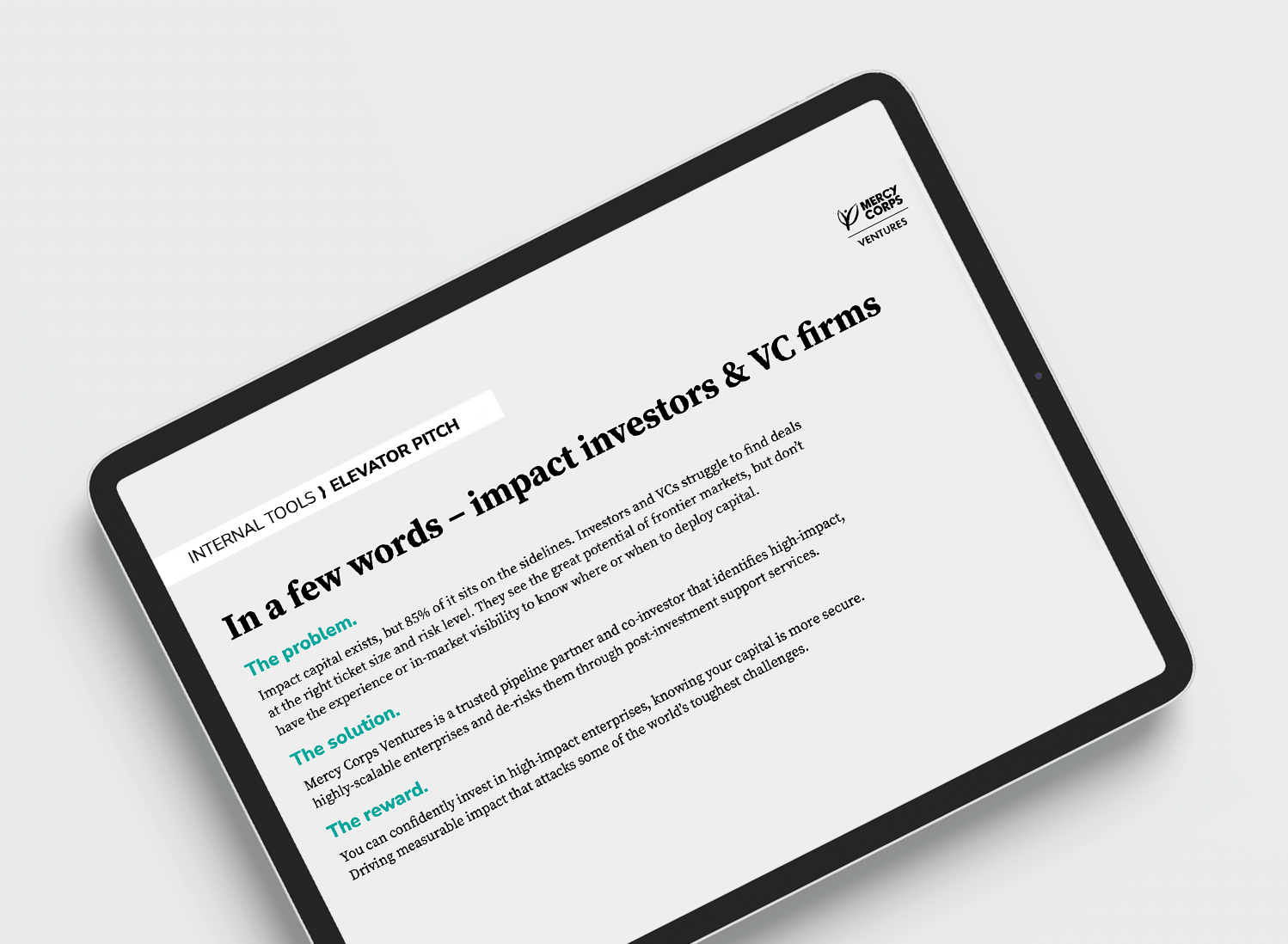
3. Message map
A message map is like your elevator pitch on steroids. It allows you to start a discussion with your standard elevator pitch (as always!). Then expand the conversation into more nuanced messaging for each priority audience. Rarely you’ll share the elevator pitch then walk away. So you’ll need a secondary level of storytelling. Then maybe even some proof points in case you’re asked follow-up questions.
Thanks to personas in your positioning strategy, you already fully understand your priority audiences. So this message map allows you to shape subsequent messages based on precisely what each particular audience wants to hear. Because what you say to a high-net-worth donor is different from a government partner is different from a customer in the community.
Another way to think about this tool is to envision a back-and-forth conversation with your target audience. What will you say, what do you want them to think, and what do you want them to do? You obviously can’t script an entire conversation. And some conversations won’t follow this flow. But it gives you a clear priority order for when to say what. And that’s all you do: craft the secondary messages that come after the elevator pitch, then tertiary statements to back it all up. One map for each audience.
Here’s a client example from Waves For Water:
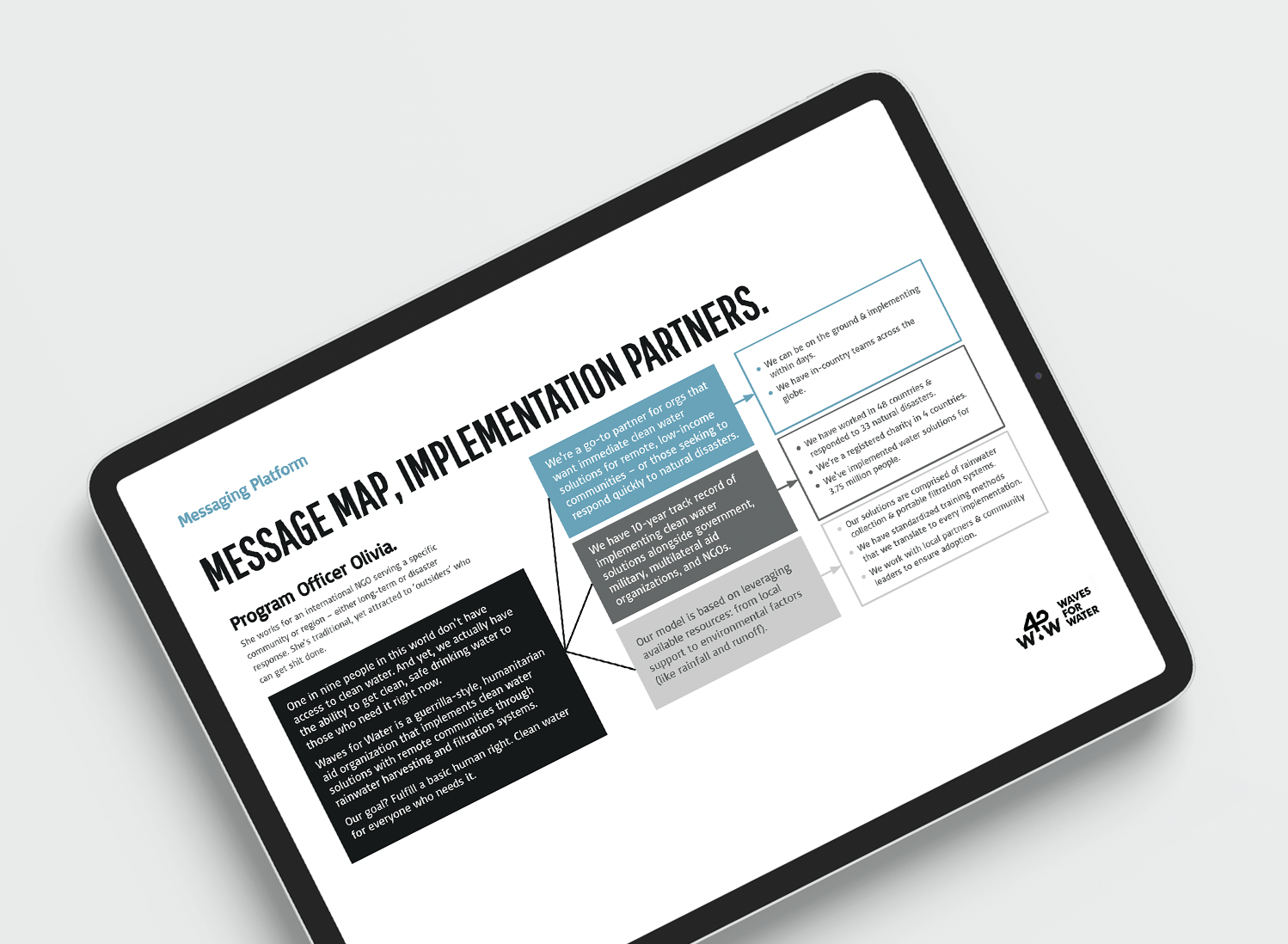
4. Public narrative
Imagine you’re at a conference full of philanthropists. You gave your laser-focused elevator pitch to the organizer — step one. Then used your message map to manage the conversation well — step two. And she was so impressed that she invited you on stage to address the entire ballroom.
That’s where this following advanced-level tool comes into play. It gives you the proper structure for any talk or speech — whether to a crowd of five or 500. Whether talking on stage, accepting an award, recruiting volunteers, speaking on a podcast, or soliciting NGO partners in the field.
Public narrative is a storytelling framework created by Harvard professor Marshall Ganz while helping Barack Obama win his presidential campaign. It was uncovered by Seth Godin and is now taught by the likes of Acumen and prominent fundraising consultant Jennifer McCrea. Roshan Paul from Amani Institute in Kenya says, “his propagation of the tool… has spawned an industry of books, TED Talks, consulting firms, and professional story coaches.”
At its roots, public narrative was designed for leaders to instill motivation into their followers, to both pursue a shared set of values and challenge the status quo. To do so with your audience, you need to nail the combination of three pieces in your story:
The story of self — sharing the turning points in your life that brought you here and permitted you to lead. People hesitate to talk about themselves or their motivations. But without that information, nobody will follow you because they don’t understand why what you’re doing matters to you.
The story of us — answering the question, “Why should we care and join in?” Nothing moves us to act more than feeling threatened or inspired. So what values, experiences, or aspirations of your audience will you appeal to when you call on them to join you in action? What stories do you share that express these values?
The story of now — inviting the crowd to join your journey with urgency, focused on action and uniting for a greater good. How can the audience begin now, at this moment? When you make the ask, it’s critical that you compel the audience to do something specific and timely. And communicate your vision for successful action.
In short: put yourself in the story, show the audience why they should care, and help them know what to do.
These public narrative stories are not set in stone, however. On the contrary, you’re encouraged to change the story of self as you address different audiences and contexts. Which in return will impact the other two. And vice-versa. Think of it more as an iterative process rather than a dead script.
The easiest way to write your public narrative is to use your founding story. Outside of the question about what you do (answer: elevator pitch), the second most common enquiry you’ll get as a leader is why you’re doing this work. Or, what started it all and where the organization came from in the first place. So this is your chance to start telling that old, self-centered founding story differently — a three-part, public narrative framework.
Here’s a grand example of self/us/now public narrative in action:
Watch James Croft and his world-class example using public narrative to build the arc of a story. Identify when Croft tells a story of self, a story of us, and a story of now as he effectively communicates hope and passionately calls us to action.
5. Boilerplate
The boilerplate is where all your strategic thinking comes together into an entire passage of content. It’s a tool borrowed from public relations, where a boilerplate is a short, standardized paragraph at the end of a press release.
We say ‘standardized’ because it’s a unit of writing you can reuse over and over without change. Whereas elements like your message map and public narrative are more flexible, your boilerplate should be rigid. Nobody (not even leaders!) should change it without ratification by the rest of the brand team.
Start with a slightly longer block of copy (500 words). Because you’ll often need that text for places like your website About page or a funder application. Then you can edit down to create shorter versions (100/50/25 words) as specific needs arise. This element of your messaging and storytelling platform is about the most ‘copywriting’ you’ll do. But, if your theory of change and positioning strategy are solid (see, broken record), there shouldn’t be much guessing about what to include here.
To create a complete, 500-word boilerplate, we can follow some primary story arc best practices. Similar to the elevator pitch structure. Lead with the problem statement, people you serve, or reason for being. Second, discuss your interventions and big idea (model), i.e., state clearly what you do. Next, you can boast a little about what makes you unique. Then cover some output and outcome impact data to create legitimacy. And just like the elevator pitch, end with some sort of payoff — like your BHAG or vision statement. Plus your basic website/contact info, if space allows.
Here’s a 100-word client example from Justice Defenders:
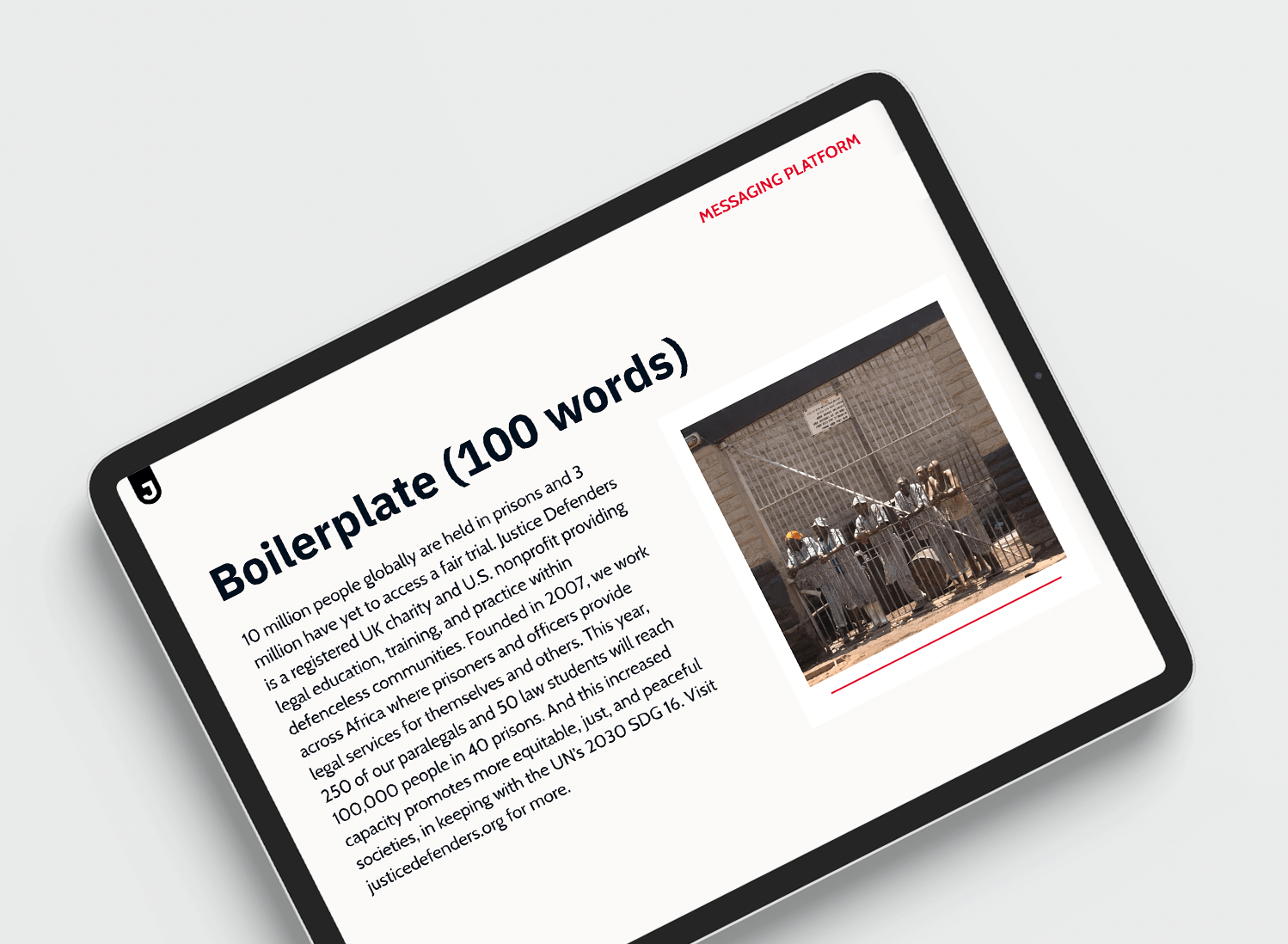
6. Impact evidence
Lack of impact evidence — or inconsistent data and testimonials — is one of the most common factors that cripples messaging and storytelling. Think about it: you can use all the previous tools. And you can have all the brilliant, compelling content in the world. But if you don’t have any decent evidence of impact or it appears differently across different channels, your trust and credibility will erode quickly. And grantmakers just won’t fund you.
A messaging and storytelling platform is not the reason to talk about monitoring and evaluation (M&E). Nor the place to collect real-world feedback from customers and beneficiaries for the first time. So if you have no impact evidence at all, skip this section. And honestly, stop your messaging work altogether. Because figuring out if you’re demonstrating real impact is far more important than figuring out how to talk about it.
But if you do have decent evidence, our goal is to merely document the most critical indicators you’ll share over and over again. Then keep this platform updated over time with the salient points everyone should always use. Because consistency is vital for messaging. Creating this section is simple: what are your 5–10 most impressive data points that demonstrate impact? Your 5–10 most potent quotes from customers, funders, or beneficiaries? These stats and words are the types of impact evidence you’d include on a website homepage.
Here’s a client example from STiR Education:
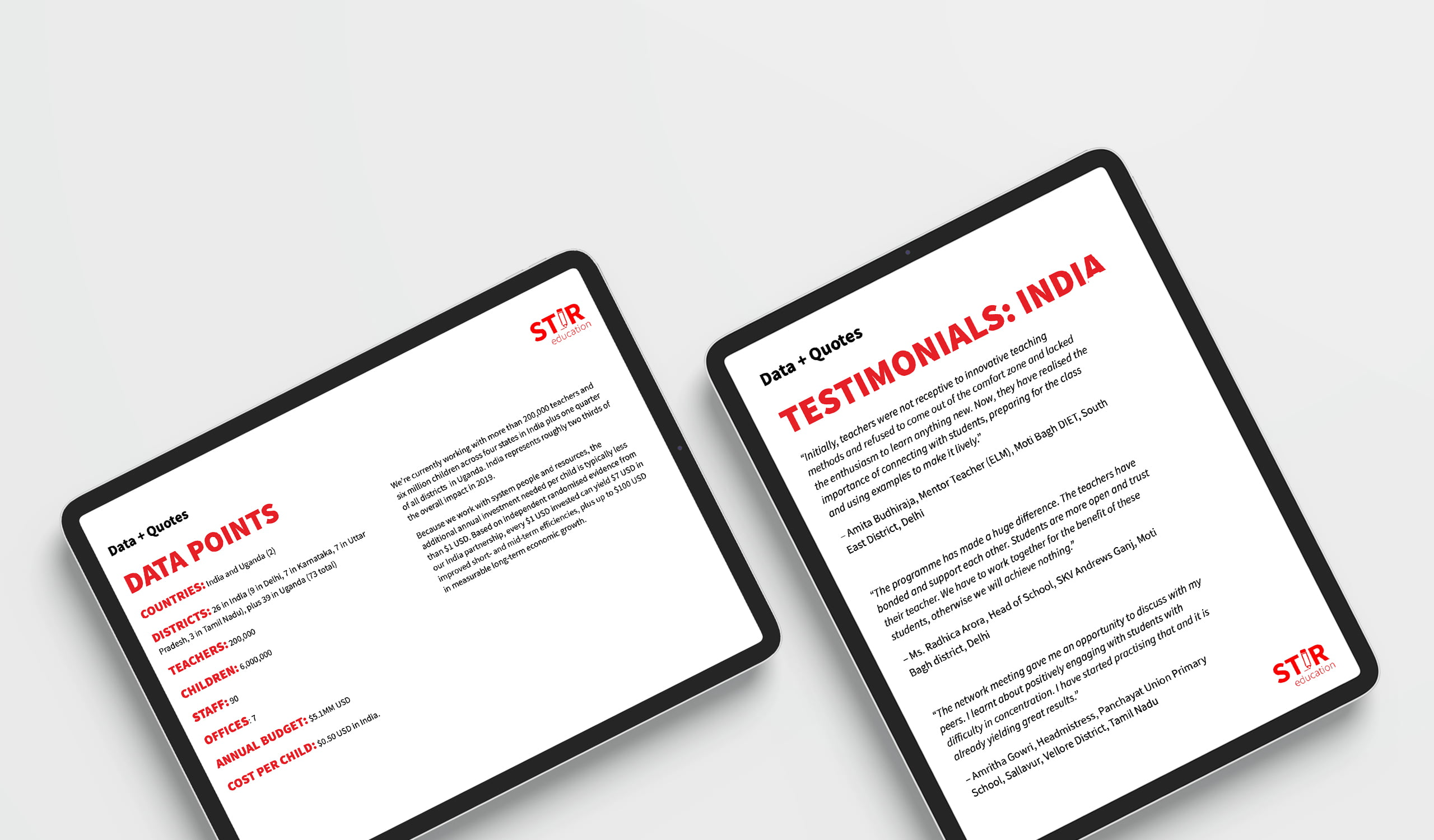
7. Word bank
First, if we haven’t beaten the dead horse enough yet, you have already determined your brand personality in the positioning strategy phase. And you’ll have 1–2 brand characters (archetypes) that match your desired personality. Each of these characters will need words or terms that give your copy the appropriate brand ‘feeling.’ Not to mention a set of words that uniquely fit your model. These are primarily adjectives and verbs.
Second, bonus points if your word bank contains a concept borrowed from the Scaling Up 7 Strata of Strategy. It’s all about mindshare and owning a word or phrase in the marketplace. “Successful brands are great at grabbing ownership of words in our minds. Volvo means safety. Google is synonymous with search. Richard Branson has taken over the word virgin. And if you hear 4-hour anything, you can’t help but think of Tim Ferriss.”
Third, it’s a good idea to develop 5–10 sample headlines. You can’t pre-write headlines for every future need. But you can determine a handful of purposeful, creative sentences that will boost ongoing copywriting efforts. These headlines can be used on your website, in email newsletters, as social graphics, or even part of major campaigns. They can be mixed and matched over time. You’ll test and measure which are effective, and continue building them out as specific needs arise.
And finally, we want to list DOs and DON’Ts around your brand terminology. Like, you DO call them customers and DON’T call them beneficiaries. Or, that you DO talk about your work in India, but DON’T yet talk about your pilot programs in China. Or, that you DON’T ever refer to your programs by this old name or that old terminology.
Here are client examples of ‘words to own:’
Vega Coffee: roasted at origin
EarthEnable: earthen floors
STiR Education: teacher intrinsic motivation
JUST: Entrepreneurial Trust Agents (JETAs)
Humanity Crew: the golden hour
And here’s a client example of a word bank from Bicycles Against Poverty (now Cycle Connect). Plus, a simple DOs and DON’Ts chart from JUST.

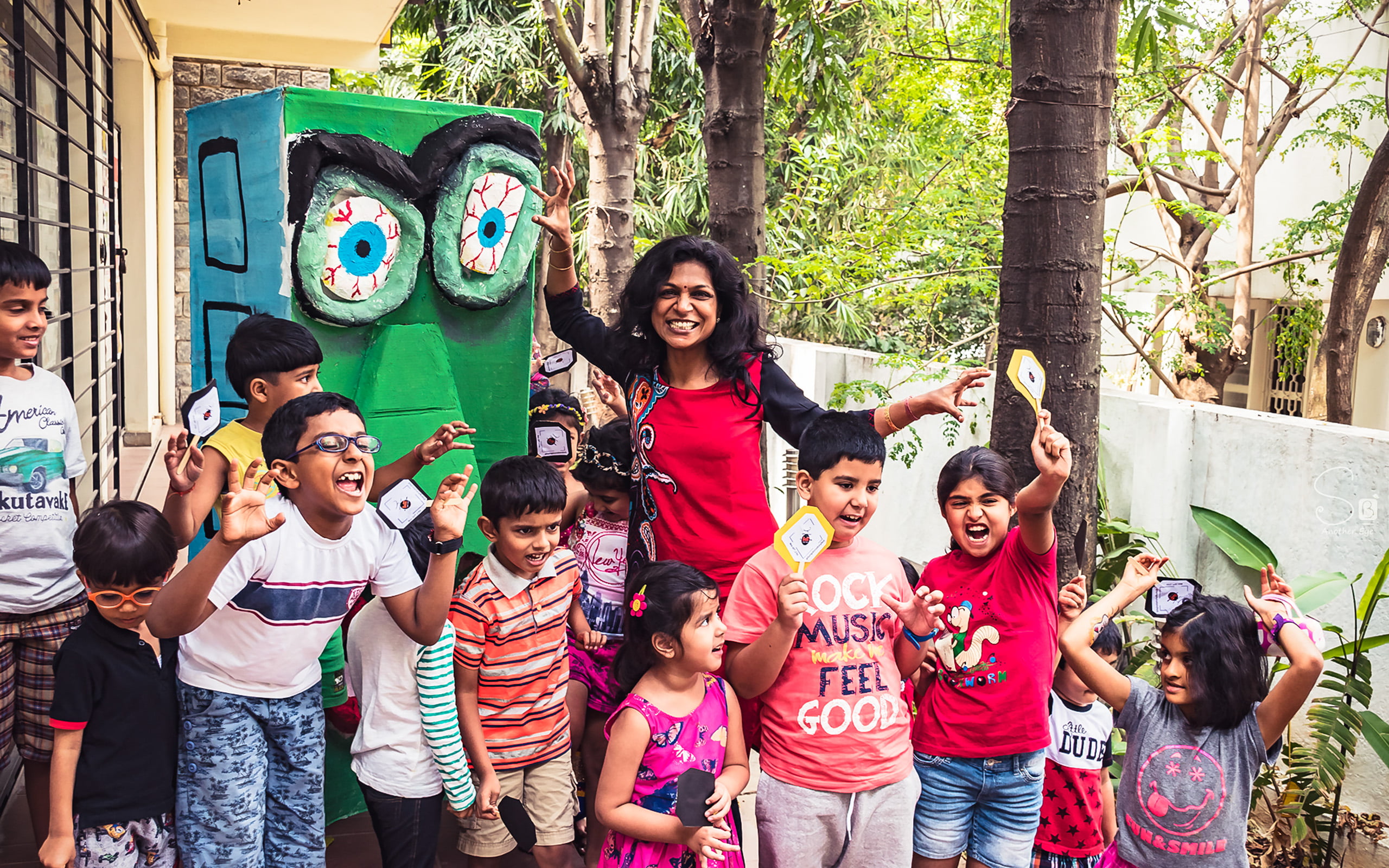
Aparna Athreya is a storyteller and life skills coach. And the founder of the educational company Kid and Parent Foundation. She says that “every story will become worth telling if we understand how to connect with our listeners.”
In conclusion: your single most powerful communications tool.
The legendary American activist Rep. John Lewis once said: “Without storytelling, the civil rights movement would have been like a bird without wings.” We agree that messaging and communications shouldn’t be an afterthought to your cause. For any nonprofit or social enterprise, comms is part of the mission too. It is your work.
If you plan to embark on the messaging and storytelling journey, keep in mind it may be challenging to complete all of it on your own. Entrepreneur and speaker Rachel Clemens believes you can’t write your own messaging platform because of the knowledge bias curse. “Once you know something, it’s impossible to imagine what it was like not to know it. So your intimate knowledge of your own organization makes you blind to how outsiders see you.”
Or, as we say at Mighty Ally: you can’t see your label from inside the jar.
According to Clemens, with that bias in mind, your messaging tends to be loaded with assumptions, shortcuts, and lingo. And to adequately describe your organization’s message in ways most likely to ‘stick’ with outsiders, you need an outsider to put them down on paper. Even if that’s just a board member or volunteer.
Whether you work at a growth-stage social venture or large grantmaker, storytelling remains your single most powerful communications tool.
The question is: are you making the most of it?
“Until the lion learns how to write, every story will glorify the hunter.”
AFRICAN PROVERB
Read more articles
Ready to get fundable and findable?
We engage three ways: consulting, training, and field building.
